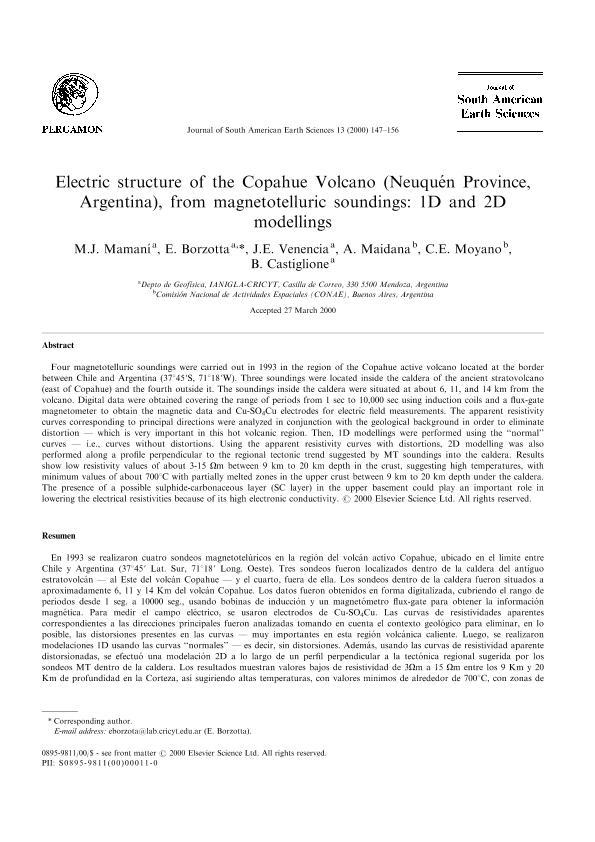Artículo
Four magnetotelluric soundings were carried out in 1993 in the region of the Copahue active volcano located at the border between Chile and Argentina (37°45'S, 71°18'W). Three soundings were located inside the caldera of the ancient stratovolcano (east of Copahue) and the fourth outside it. The soundings inside the caldera were situated at about 6, 11, and 14 km from the volcano. Digital data were obtained covering the range of periods from 1 sec to 10,000 sec using induction coils and a flux-gate magnetometer to obtain the magnetic data and Cu-SO 4Cu electrodes for electric field measurements. The apparent resistivity curves corresponding to principal directions were analyzed in conjunction with the geological background in order to eliminate distortion - which is very important in this hot volcanic region. Then, 1D modellings were performed using the 'normal' curves - i.e., curves without distortions. Using the apparent resistivity curves with distortions, 2D modelling was also performed along a profile perpendicular to the regional tectonic trend suggested by MT soundings into the caldera. Results show low resistivity values of about 3-15 Ωm between 9 km to 20 km depth in the crust, suggesting high temperatures, with minimum values of about 700°C with partially melted zones in the upper crust between 9 km to 20 km depth under the caldera. The presence of a possible sulphide-carbonaceous layer (SC layer) in the upper basement could play an important role in lowering the electrical resistivities because of its high electronic conductivity. En 1993 se realizaron cuatro sondeos magnetotelúricos en la región del volcán activo Copahue, ubicado en el lı́mite entre Chile y Argentina (37°45′ Lat. Sur, 71°18′ Long. Oeste). Tres sondeos fueron localizados dentro de la caldera del antiguo estratovolcán — al Este del volcán Copahue — y el cuarto, fuera de ella. Los sondeos dentro de la caldera fueron situados a aproximadamente 6, 11 y 14 Km del volcán Copahue. Los datos fueron obtenidos en forma digitalizada, cubriendo el rango de perı́odos desde 1 seg. a 10000 seg., usando bobinas de inducción y un magnetómetro flux-gate para obtener la información magnética. Para medir el campo eléctrico, se usaron electrodos de Cu-SO4Cu. Las curvas de resistividades aparentes correspondientes a las direcciones principales fueron analizadas tomando en cuenta el contexto geológico para eliminar, en lo posible, las distorsiones presentes en las curvas — muy importantes en esta región volcánica caliente. Luego, se realizaron modelaciones 1D usando las curvas “normales” — es decir, sin distorsiones. Además, usando las curvas de resistividad aparente distorsionadas, se efectuó una modelación 2D a lo largo de un perfil perpendicular a la tectónica regional sugerida por los sondeos MT dentro de la caldera. Los resultados muestran valores bajos de resistividad de 3Ωm a 15 Ωm entre los 9 Km y 20 Km de profundidad en la Corteza, ası́ sugiriendo altas temperaturas, con valores minimos de alrededor de 700°C, con zonas de fusión parcial en la Corteza superior entre los 9 Km y los 20 Km de profundidad bajo la caldera. La presencia de una posible capa sulfuro-carbonática (capa SC) emplazada en el sector superior del basamento podrı́a jugar un papel importante en descender las resistividades eléctricas debido a su alta conductividad electrónica.
Electric structure of the Copahue Volcano (Neuquen Province, Argentina), from magnetotelluric soundings: 1D and 2D modellings
Mamani, Manuel Jesus ; Borzotta, Enrique
; Borzotta, Enrique ; Venencia, Jorge Eduardo
; Venencia, Jorge Eduardo ; Maidana, A.; Moyano, C.E.; Castiglione, B
; Maidana, A.; Moyano, C.E.; Castiglione, B
 ; Borzotta, Enrique
; Borzotta, Enrique ; Venencia, Jorge Eduardo
; Venencia, Jorge Eduardo ; Maidana, A.; Moyano, C.E.; Castiglione, B
; Maidana, A.; Moyano, C.E.; Castiglione, B
Fecha de publicación:
05/2000
Editorial:
Pergamon-Elsevier Science Ltd
Revista:
Journal of South American Earth Sciences
ISSN:
0895-9811
Idioma:
Inglés
Tipo de recurso:
Artículo publicado
Clasificación temática:
Resumen
Palabras clave:
Copahue Volcano
Archivos asociados
Licencia
Identificadores
Colecciones
Articulos(IANIGLA)
Articulos de INST. ARG. DE NIVOLOGIA, GLACIOLOGIA Y CS. AMBIENT
Articulos de INST. ARG. DE NIVOLOGIA, GLACIOLOGIA Y CS. AMBIENT
Citación
Mamani, Manuel Jesus; Borzotta, Enrique; Venencia, Jorge Eduardo; Maidana, A.; Moyano, C.E.; et al.; Electric structure of the Copahue Volcano (Neuquen Province, Argentina), from magnetotelluric soundings: 1D and 2D modellings; Pergamon-Elsevier Science Ltd; Journal of South American Earth Sciences; 13; 1-2; 5-2000; 147-156
Compartir
Altmétricas



